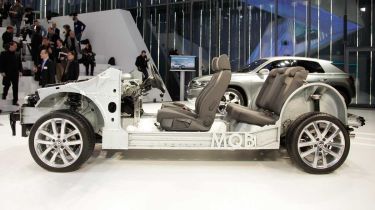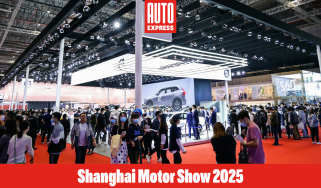New VW MQB unveiled
Volkswagen reveals the new platform that will form the basis of the next Golf and Audi A3
This is the new VW Golf – and the new Audi A3 and new Skoda Octavia. In fact, this chassis will pretty much underpin the majority of VW Group models, from Polo-sized superminis to those as big as the next Passat.
Called MQB, the new platform represents much more than a chassis that can be adapted for use in a wide variety of models. VW calls it "the backbone of light and safe cars" as it also encapsulates new lightweight drivetrains, hi-tech safety equipment and even iPad-style infotainment systems.
It moves the game on from simply offering a chassis that can be stretched or shortened to fit different cars, to one that shares its electrical wiring, engines, transmissions, air-conditioning systems, seat backs and infotainment systems. It even includes the factories the cars will be built in – for the first time allowing VW, Audi and Skoda models to be built on the same production line.
But the most important car of the lot is the new Golf. And the Mk7 will represent a huge leap forward. Thanks to hot formed steel that's six-times stronger than conventional steel, more aluminium in the suspension, together with lightweight air-con, it will weigh up to 60kg less than the Mk6. VW says it will weigh as much as the Mk4.
Under the bonnet will be a range of new engines, all of which will have the same angle of tilt – whether petrol or diesel – in the engine bay. This will speed up the production line and allow the same transmissions to be used throughout. In fact, engine and gearbox variants have been reduced by 88 per cent.
The petrol line-up consists of a new 1.2 TSI turbo four-cylinder with 84bhp or 104bhp, and a 1.4 TSI with 120bhp or 138bhp. The latter has already appeared in the Audi A1 Sportback, and features cylinder deactivation, so it can run on two cylinders under a light throttle, saving fuel. Thanks to lightweight aluminium, the engine weighs 16kg less than the 1.4 TSi in the current Golf.
The new Golf will also be available as a hybrid, with the 1.4 TSI boosted by a 20kW electric motor. It produces 145bhp and 250Nm of torque. This will also be available as a plug-in hybrid, this time with an 80kW electric motor. This can return up to 141mpg and emit less than 46g/km of CO2.
As for diesels, there will be a new line-up of 1.6 and 2.0-litre TDI diesels with power ranging from 89bhp to 187bhp. There is no word on a BlueMotion variant, but VW says even the basic engines reduce CO2 emissions by 7g/km, so expect a new Golf BlueMotion to emit less than 90g/km of CO2 and achieve more than 80mpg. There will also be a low-capacity 800cc diesel appearing in the future. Seven-speed DSG automatic and six-speed manual gearboxes will feature, too.
The new Golf will also be far safer. Thanks to a camera mounted above the rear-view mirror, it will have road sign recognition, lane keep assistance, light assist – which automatically dims the lights to prevent dazzling oncoming traffic – and adaptive cruise control. It will also have a Mercedes-style fatigue assist system, which warns the driver if he or she is about to fall asleep at the wheel.
Other Mercedes-style safety equipment includes pre-crash – which shuts the windows and pre-tensions the seatbelts if it senses a crash is imminent – as well as a system that can help avoid multiple crashes. In other words, it will automatically apply the brakes after the first collision if the car senses it is at risk of a secondary collision – a typical motorway crash situation. This is in addition to low-speed crash mitigation for use in towns.
VW will also launch its next-generation automatic parking system, which not only steers the car into a parellel parking space, but reverses it into a multi-storey car parking space, too.
To aid handling, the Golf will get a development of a new electronically-controlled differential which was significantly tested in a VW Scirocco race car at the Nurburgring 24 Hours. In addition to traction control and the XDS electronic differential, it offers torque vectoring, and is said to help turn-in and allow the Golf to hold on to its line better when cornering. There is also a new electric steering system.
Inside, the MK7 Golf will get a new touchscreen interface on the centre console which works in a similar way to an iPad, allowing the driver to use a ‘sweep’ gesture to access different information. It will be available with five and eight-inch screens.
The MQB platform will also allow the next Golf to be better looking: “Because of the position of the engine, MQB means shorter front overhangs, which in turn allows us to lengthen the look of the car and make it more sporty with a lower centre of gravity,” said head of exterior design Andreas Mindt. Better packaging will allow larger wheels and a longer wheelbase. Mindt also said that the Cross Coupe concept’s wider ‘face’, with its radiator grille integrated with the headlights and daytime running lights, would be a big feature of upcoming models.
The first VW Group model to get MQB will be the new Audi A3, which debuts in the summer – we’ll then see it in the new Mk7 Golf, which is set to arrive at the Paris Motor Show in September, before going on sale in 2013.
Find a car with the experts







